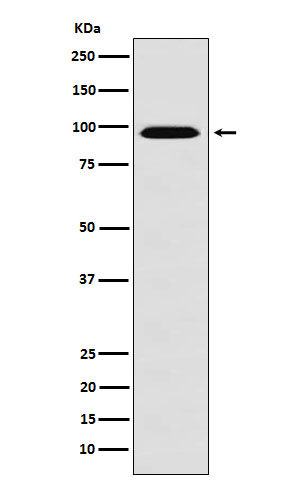Anti-RanBP9 Rabbit Monoclonal Antibody
- SPECIFICATION
- CITATIONS
- PROTOCOLS
- BACKGROUND

Application
| WB, IF, ICC |
|---|---|
| Primary Accession | Q96S59 |
| Host | Rabbit |
| Isotype | IgG |
| Reactivity | Rat, Human, Mouse |
| Clonality | Monoclonal |
| Format | Liquid |
| Description | Anti-RanBP9 Rabbit Monoclonal Antibody . Tested in WB, ICC/IF applications. This antibody reacts with Human, Mouse, Rat. |
| Gene ID | 10048 |
|---|---|
| Other Names | Ran-binding protein 9, RanBP9, BPM-L, BPM90, Ran-binding protein M, RanBPM, RanBP7, RANBP9, RANBPM |
| Calculated MW | 91 kDa |
| Application Details | WB 1:500-1:2000 ICC/IF 1:50-1:200 |
| Contents | Rabbit IgG in phosphate buffered saline, pH 7.4, 150mM NaCl, 0.02% sodium azide and 50% glycerol, 0.4-0.5mg/ml BSA. |
| Clone Names | Clone: 25R64 |
| Immunogen | A synthesized peptide derived from human RanBP9 |
| Purification | Affinity-chromatography |
| Storage | Store at -20°C for one year. For short term storage and frequent use, store at 4°C for up to one month. Avoid repeated freeze-thaw cycles. |
| Name | RANBP9 |
|---|---|
| Synonyms | RANBPM |
| Function | May act as scaffolding protein, and as adapter protein to couple membrane receptors to intracellular signaling pathways (Probable). Acts as a mediator of cell spreading and actin cytoskeleton rearrangement (PubMed:18710924). Core component of the CTLH E3 ubiquitin-protein ligase complex that selectively accepts ubiquitin from UBE2H and mediates ubiquitination and subsequent proteasomal degradation of the transcription factor HBP1 (PubMed:29911972). May be involved in signaling of ITGB2/LFA-1 and other integrins (PubMed:14722085). Enhances HGF-MET signaling by recruiting Sos and activating the Ras pathway (PubMed:12147692). Enhances dihydrotestosterone-induced transactivation activity of AR, as well as dexamethasone-induced transactivation activity of NR3C1, but not affect estrogen-induced transactivation (PubMed:12361945, PubMed:18222118). Stabilizes TP73 isoform Alpha, probably by inhibiting its ubiquitination, and increases its proapoptotic activity (PubMed:15558019). Inhibits the kinase activity of DYRK1A and DYRK1B. Inhibits FMR1 binding to RNA. |
| Cellular Location | Cytoplasm. Nucleus. Cell membrane; Peripheral membrane protein. Note=The unphosphorylated form is predominantly cytoplasmic. A phosphorylated form is associated with the plasma membrane. |
| Tissue Location | Ubiquitously expressed, with highest levels in testes, placenta, heart, and muscle, and lowest levels in lung. Within the brain, expressed predominantly by neurons in the gray matter of cortex, the granular layer of cerebellum and the Purkinje cells |

Thousands of laboratories across the world have published research that depended on the performance of antibodies from Abcepta to advance their research. Check out links to articles that cite our products in major peer-reviewed journals, organized by research category.
info@abcepta.com, and receive a free "I Love Antibodies" mug.
Provided below are standard protocols that you may find useful for product applications.
If you have used an Abcepta product and would like to share how it has performed, please click on the "Submit Review" button and provide the requested information. Our staff will examine and post your review and contact you if needed.
If you have any additional inquiries please email technical services at tech@abcepta.com.













 Foundational characteristics of cancer include proliferation, angiogenesis, migration, evasion of apoptosis, and cellular immortality. Find key markers for these cellular processes and antibodies to detect them.
Foundational characteristics of cancer include proliferation, angiogenesis, migration, evasion of apoptosis, and cellular immortality. Find key markers for these cellular processes and antibodies to detect them. The SUMOplot™ Analysis Program predicts and scores sumoylation sites in your protein. SUMOylation is a post-translational modification involved in various cellular processes, such as nuclear-cytosolic transport, transcriptional regulation, apoptosis, protein stability, response to stress, and progression through the cell cycle.
The SUMOplot™ Analysis Program predicts and scores sumoylation sites in your protein. SUMOylation is a post-translational modification involved in various cellular processes, such as nuclear-cytosolic transport, transcriptional regulation, apoptosis, protein stability, response to stress, and progression through the cell cycle. The Autophagy Receptor Motif Plotter predicts and scores autophagy receptor binding sites in your protein. Identifying proteins connected to this pathway is critical to understanding the role of autophagy in physiological as well as pathological processes such as development, differentiation, neurodegenerative diseases, stress, infection, and cancer.
The Autophagy Receptor Motif Plotter predicts and scores autophagy receptor binding sites in your protein. Identifying proteins connected to this pathway is critical to understanding the role of autophagy in physiological as well as pathological processes such as development, differentiation, neurodegenerative diseases, stress, infection, and cancer.


